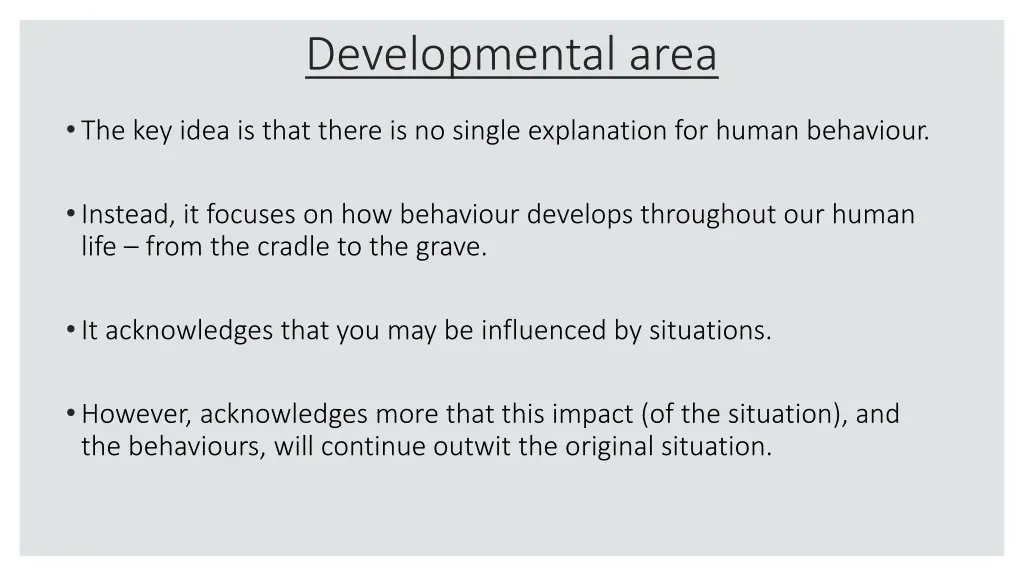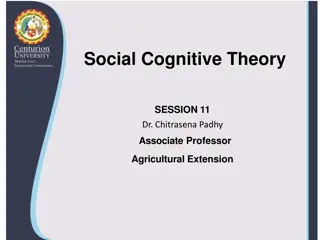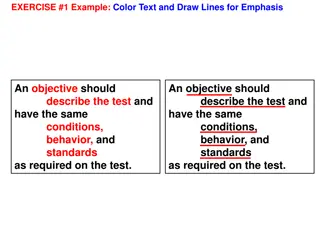
Understanding Human Behavior Development Throughout Life
Explore the complexity of human behavior development from birth to death, emphasizing the role of external influences and observational learning. Discover the strengths and weaknesses of longitudinal studies in shedding light on the multifaceted nature of human behavior. Dive into key studies like Bandura's Transmission of Aggression and gain insights into how behavior evolves over a lifetime.
Download Presentation

Please find below an Image/Link to download the presentation.
The content on the website is provided AS IS for your information and personal use only. It may not be sold, licensed, or shared on other websites without obtaining consent from the author. If you encounter any issues during the download, it is possible that the publisher has removed the file from their server.
You are allowed to download the files provided on this website for personal or commercial use, subject to the condition that they are used lawfully. All files are the property of their respective owners.
The content on the website is provided AS IS for your information and personal use only. It may not be sold, licensed, or shared on other websites without obtaining consent from the author.
E N D
Presentation Transcript
Developmental area The key idea is that there is no single explanation for human behaviour. Instead, it focuses on how behaviour develops throughout our human life from the cradle to the grave. It acknowledges that you may be influenced by situations. However, acknowledges more that this impact (of the situation), and the behaviours, will continue outwit the original situation.
Strengths Weaknesses To study humans over their lifetime the experiments are typically longitudinal (conducted over a long period of time). This is often rich in data as they inform us of how humans change and develop throughout life. Longitudinal studies which comprise the area require a great deal of time, compared to other studies. Considers a range of influencing factors nature and nurture. The area of focus is very general, this makes it difficult to pin-point one single influencing factor
Studies Bandura (1961) Transmission of aggression Chaney (2004) Funhaler study
Bandura (1961) Transmission of aggression Area: Developmental Theme: External influences on children's behaviour
Columbine High School shooting Background
Background Murder of Jamie Bulger
Does watching an aggressive model reduce your own aggression or does it increase your own aggression?
Background Behaviourism is a psychological perspective (we will learn this later in the year). In summary, behaviourists believe that all behaviour can be explained as a result of the immediate immediate environment. Bandura introduced the Social Learning Theory Social Learning Theory. This claims that people learn behaviour through observation learning through the immediate imitation observation and show their https://www.youtube.com/watch?v=faQLb_FfKWU
Bandura and Bobo Association for Psychological Science APS Key terms Imitation to copy a behaviour you have just observed Bobo doll an inflatable toy which is weighted at the bottom. When hit, the doll bounces back up Inter-rater reliability -
Aim Bandura wanted to research whether children would imitate aggressive behaviour displayed by a model . Specifically, would they imitate this aggressive behaviour when the model is absent
Hypothesis Hypothesis 1: Subjects exposed to aggressive resembling those of their models. aggressive models would reproduce aggressive aggressive acts Hypothesis 2: Observation of non inhibiting inhibiting effect on the subjects subsequent behaviour (their normal behaviour) non- -aggressive aggressive models would display a generalised Hypothesis 3: Participants would imitate the behaviour of a same degree than a model of the opposite opposite sex . same- -sex sex model to a greater Hypothesis 4: Boys Boys should be more pre-disposed than girls girls toward imitating aggression.
Method Laboratory experiment Independent Variables (IV) Condition (Aggressive, non-aggressive or control group no model) Gender of child (male or female) Gender of model (male or female) Dependent Variables (DV) Measure of aggression
Method Snapshot study takes place over a short period of time. Each child is studied for 32 minutes. Sample 72 boys and girls from Stanford University Nursery 24 children are allocated to each condition (aggressive, non aggressive, control) Within each condition is the following: 6 boys with same sex model 6 boys with opposite sex model 6 girls with same sex model 6 girls with opposite sex model
Method Pre-testing and matching The experimenter and the children s nursery school teacher rated the children on four levels before the experiment started 1. Physical aggression 2. Verbal aggression 3. Aggression towards inanimate objects 4. Aggression inhibition There was 0.89 correlation between ratings (High inter rater reliability) Based on scores, children were matched into the threes. Matched pairs design
Procedure Stage 1 (10 minutes) Child plays alone in room 1 making potato prints. An adult (the model) enters the room. If in aggressive condition the model will start to attack the Bobo doll If in non-aggressive condition the model will play quietly with other toys If in control condition no model enters the room
Procedure Stage 2 (2 minutes) Child is taken into room 2. Mild aggression arousal stage Mild aggression arousal stage Children is allowed to play with attractive (fancy) toys for two minutes. They were told these are the experimenters best toys and only reserved for the best boys and best girls. The child is told they are not either of those so are now not allowed to play with the toys. They are told they can play with any other toy in room 1 Why do they do this?
Procedure Stage 3 (20 minutes) The child is brought back into room 1. In this room are aggressive toys (3ft bobo doll) and trucks (non-aggressive toy). For 20 minutes the child is observed at 5 second intervals. During which they are observed on their: Imitative behaviour Direct copy of the model s behaviour (Punching, kicking, throwing in air) Partially imitative behaviour Similar but not exact copy of the model s behaviour (sits on bobo doll) Non-imitative aggressive behaviour General aggressive behaviour (Pretends to shoot bobo doll this behaviour is not shown by model)
Procedure Stage 3 (20 minutes) The observation is carried out behind a one-way mirror by the male model What issues are there with this? On half of the trials, the children are observed by a second observer. Inter rater reliability was high
Results quantitative Hypothesis 1: Subjects exposed to aggressive aggressive models would reproduce aggressive aggressive acts resembling those of their models. Was this found to be true? Mean number of imitative physical aggressive acts Girls Boys Aggressive female model 5.5 12.4 Aggressive male model 7.2 25.8 Hypothesis 2: Observation of non aggressive aggressive models would display a generalised inhibiting inhibiting effect on the subjects subsequent behaviour (their normal behaviour) Was this found to be true? non- - Non-aggressive female model 2.5 0.2 Non-aggressive male model 0 1.5 Control 1.2 2.0
Results quantitative Mean number of imitative physical aggressive acts Hypothesis 3: Participants would imitate the behaviour of a same sex sex model to a greater degree than a model of the opposite Was this found to be true? Girls Boys same- - Aggressive female model 5.5 12.4 opposite sex . Aggressive male model 7.2 25.8 Non-aggressive female model 2.5 0.2 Hypothesis 4: Boys more pre-disposed than girls toward imitating aggression. Was this found to be true? Boys should be Non-aggressive male model 0 1.5 girls Control 1.2 2.0
Results quantitative Hypothesis 1: Subjects exposed to aggressive aggressive models would reproduce aggressive aggressive acts resembling those of their models. Was this found to be true? Mean number of imitative verbal aggressive acts Girls Boys Aggressive female model 13.7 4.3 Aggressive male model 2.0 12.7 Hypothesis 2: Observation of non aggressive aggressive models would display a generalised inhibiting inhibiting effect on the subjects subsequent behaviour (their normal behaviour) Was this found to be true? non- - Non-aggressive female model 0.3 1.1 Non-aggressive male model 0 0 Control 0.7 1.7
Results quantitative Mean number of imitative verbal aggressive acts Hypothesis 3: Participants would imitate the behaviour of a same sex sex model to a greater degree than a model of the opposite Was this found to be true? Girls Boys same- - Aggressive female model 13.7 4.3 opposite sex . Aggressive male model 2.0 12.7 Non-aggressive female model 0.3 1.1 Hypothesis 4: Boys more pre-disposed than girls toward imitating aggression. Was this found to be true? Boys should be Non-aggressive male model 0 0 girls Control 0.7 1.7
Results - qualitative This is a selection of quotes from the participants: Al s a good socker, he beat up Bobo. I want to sock like Al. That man is a strong fighter, he punched and punched and he could hit Bobo right down to the floor. Punch your nose. He s a good fighter like Daddy.
Conclusions The findings support the social learning theory. In other words, children learn social behaviours (both aggressive and non- aggressive) through observation learning (watching the behaviour of others). This supports SLT.
Task: Evaluation Evaluation Evaluation Research method Laboratory Snapshot study Matched pairs design Type of data Qualitative and quantitative Ethical guidelines Can children give consent? Do they know they can stop taking part? Can they be deceived?
Task: Evaluation Validity Internal validity the aim of Bandura s study was to measure external influences on children s behaviour. Did it do this? Or did other factors influence? Reliability Is the study highly controlled? Is it standardised? If yes, it has internal reliability. If not, it does not.
Task: Evaluation Sampling bias Gender split? University nursery? Practical applications Who might this be useful to in society? Ethnocentrism = cultural bias Yes there is cultural bias = the study is ethnocentric No there is no cultural bias = the study is not ethnocentric The study was conducted in America. What does this mean in terms of cultural bias?
Task: Answer exam questions 1-12






















